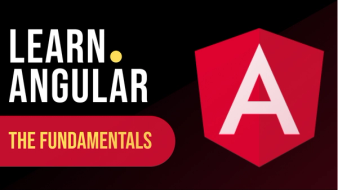1.1. Angular fundamentals

This course teaches the fundamentals of Angular, including its architecture, components, modules, directives, and services. Beginners will learn how to set up their development environment, create components, use data binding, handle user events, and more. Advanced topics include creating dynamic templates, organizing code with modules, making API requests with HTTP, and deploying apps. By the end of the course, learners will have the skills to build their own web applications and continue growing their knowledge of Angular.
Angular is a powerful front-end development framework that allows developers to build dynamic and responsive web applications. If you are new to Angular, installing and serving your first Angular application may seem daunting. However, with the right guidance, it can be a straightforward process.

Learn about input, output, and behavior subjects in reactive programming, a coding approach that responds to data stream changes or events. Input subjects receive new values and send them to dependent program parts. Output subjects can be observed by other parts and trigger reactions. Behavior subjects are a type of output subject that has a default value and emits it immediately upon subscription, followed by subsequent updates. Discover how these programming concepts can be applied in various scenarios to build reactive applications.


In this module, we're going to look into Angular more in-depth and explore the concepts such as `interceptors`, `guards`, and reactive programming with `reactive forms` and `Reactive Extensions Library` (RxJs). We're also going to look into change detection strategies and how they can be used to optimize the build.

In this module where we are going to delve deeper into the world of Angular and explore some fascinating concepts that will help you become a better developer. In this module, we will take a closer look at some of the key concepts and features of Angular that are essential for building robust and scalable applications.
One of the concepts that we will explore in more depth is design patterns. Design patterns provide a way to solve common problems in software development by encapsulating the best practices and proven solutions in a reusable format. Understanding design patterns is essential for developing high-quality and maintainable code, and it can help you write code that is more efficient, readable, and easy to maintain.
Another important concept that we will explore is change detection. In Angular, change detection is a critical part of the application lifecycle, and it plays a crucial role in ensuring that the UI is updated correctly and efficiently. We will learn how change detection works in Angular, and we will explore different strategies for optimizing change detection performance in your applications.
In addition to these concepts, we will also explore other interesting approaches in Angular, such as reactive programming and the use of observables. Reactive programming is a powerful paradigm that can simplify complex asynchronous operations, and observables provide a way to handle asynchronous events in a more elegant and streamlined way.
Finally, we will also look into change-optimizing builds and setting up deployments. Building and deploying Angular applications can be a complex and time-consuming process, but there are several tools and techniques that can help you streamline the process and make it more efficient. We will explore different strategies for optimizing your builds and deployments, including code splitting, lazy loading, and other advanced techniques.
By the end of this module, you will have a deeper understanding of Angular and the key concepts and features that make it such a powerful framework for building modern web applications. You will have the skills and knowledge to write more efficient, scalable, and maintainable code, and you will be well-equipped to tackle even the most complex development challenges.
The course "Getting Started with Angular" is designed for individuals who are new to the Angular framework and want to learn how to build web applications using this powerful tool. The course covers the fundamentals of Angular, including its architecture, components, modules, directives, and services.
In the beginning, learners will be introduced to the basics of Angular, such as setting up their development environment and understanding the structure of an Angular application. They will also learn how to create their first Angular component, how to use data binding to display data, and how to handle user events.
As the course progresses, learners will delve deeper into more advanced topics, such as creating dynamic templates using Angular directives, using Angular modules to organize code, and implementing services to handle data. They will also learn how to build a complete Angular application, including implementing routing and navigation, using HTTP to make API requests, and deploying their application to a hosting service.
By the end of the course, learners will have a solid understanding of the fundamentals of Angular and will be able to build their own web applications using this powerful framework. They will also have the skills necessary to continue learning and growing their knowledge of Angular as they become more advanced in their development journey.